Hussain AlMoosawi is a multidisciplinary creative with vast experience in photography, visual journalism, and design. Exhibiting his series "Under Construction: Fences of the UAE" at GPP’s Photo Week 2017, kickstarted a long-standing collaboration, at varying degrees, between us and the creative. We are proud to represent him as one of our most beloved and best-selling Editions artists over the years.
Interviewed by our former Editions and Exhibitions Manager, Adele Bea Cipste, Hussain provides an insightful, fascinating deep-dive into his meticulous creative process and decodes his expansive, long-term project Facades of the UAE.

Hussain was born and raised in Dubai and now resides in Abu Dhabi
For starters, could you tell me about your work as you would to someone who knows very little about it.
So what I do in brief, is I document facades of buildings all across the country. My project aims to give us a better understanding of the UAE’s architectural heritage since the unification of the country until the present day.
How long has this documentation been going on?
I started in 2017 with facades. Before that for a year, I was documenting more industrial facades until I decided to focus on symmetry in 2017. I've started in Abu Dhabi and photographed a little bit of Dubai as well.
What is your relationship with each of the cities you document? How is it different to shoot in Abu Dhabi as compared to Dubai or Sharjah?
I was born and bred in Dubai. My childhood was spent in that city. Sharjah as well, because they are so close to each other – Abu Dhabi a bit less in terms of treasured memories, but it’s where I’ve lived since coming back from Australia in 2013. I think that somehow contributed to my objectivity towards my project there. I’m not doing what I'm doing for the purpose of nostalgia. Many people look at what I do through the lens of nostalgia, but I don’t perceive it that way because I did not grow up there. Subjectivity possibly gets factored into my projects in Dubai and Sharjah subconsciously. Still, I aim to be as objective as possible.
Practically speaking, I photographed more of Dubai and Abu Dhabi. Many people ask me, "Why don't you have enough photographs in Sharjah?’’ Well, it's just a matter of practicalities. And I've reached a stage where I'm almost resorting back to my old method of finishing off certain areas before starting with others. This goes back to when I used to live in Melbourne, or even when I go to different cities and take pictures. I would map the city and decide where I will photograph and then I go in order, from one neighborhood to the next.
Initially, there were a number of buildings or facades in Abu Dhabi that I believed were quite prominent. I then reached a stage where all the ‘masterpieces’ have been photographed. Then I started to look at every street and what every street holds in terms of something that is worthy of documentation.
Right now, I'm pretty much following the grid of the city. I enjoy it more this way because it gives me clarity on what I've accomplished and what is yet to be photographed. I covered Falah, Defence Road, Hazza’ bin Zayed the First. And then I discovered pockets in the Tourist Club area that surprised me. I'm not taking many pictures in Dubai at the moment unless there’s a building that is to be demolished; then I would spend effort to get that photographed.
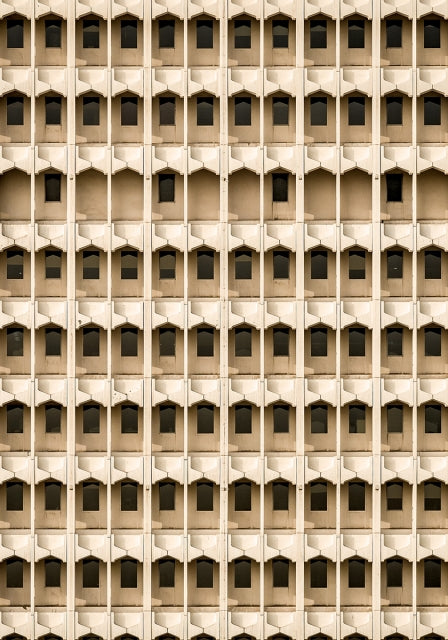
Artwork title
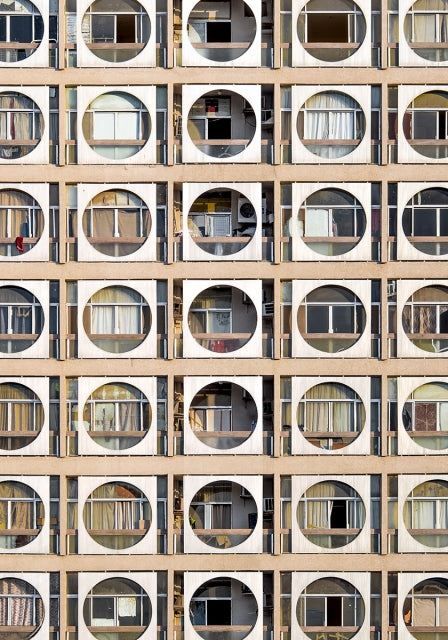
Artwork title
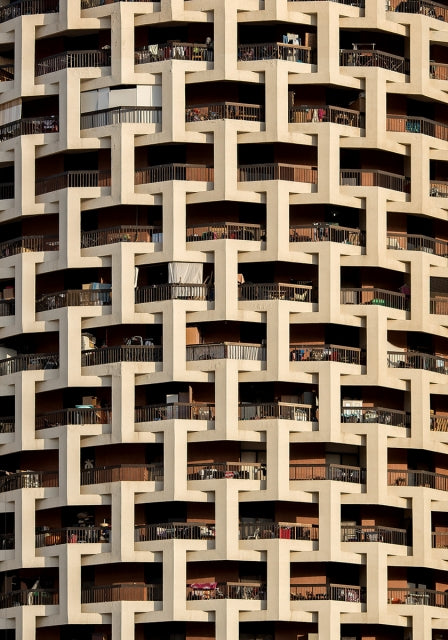
Artwork title
‘Hero facades,’ as Hussain has previously referred to them
You must be a great person to walk through Abu Dhabi with.
Do you also read into the context and history of the buildings, or do you document mainly what attracts you visually?
So my research is pictorial research. Sometimes I would photograph the building, and then do the research. Sometimes I’d know something about a certain building, and I photograph it for that reason. Usually this information would already be in the public sphere, not something I investigated and found out.
I would read about the architecture in Abu Dhabi, and if I knew that something is valuable, then I would photograph it even if I don't see it as visually attractive. I think I trust my intuition to a great degree, and discovered that many buildings I photographed happen to be of social value. And so because at the end, at least at this stage, I'm taking pictures of buildings that might not always personally appeal to me, but those samples, according to my intuition, I see as unique. So that's the way I describe it.
I happen to cover a lot of these buildings before actually knowing their value. Ideally, I have to be working with research given the number of buildings that I’ve photographed, but I just cannot do all of it now. However, that's pretty much the convention as with commissioned projects where, you know, I was a photographer and there was a researcher working on material. It is not a straightforward job. Many documents don't happen to exist anymore. Whether it’s looking at floor plans, or any kind of contracts related to buildings in the 80s. Globally, documents for that time period exist, but not in the UAE. So, you might spend a lot of time just trying to identify the architect of a building. The owner will be known. But finding out who designed a building and why? These stories remain quite hidden. It’s difficult and sometimes impossible to trace because documentation may have not existed or has been destroyed. At this stage, I just try to document as many buildings as possible because many will potentially be demolished.
It’s quite a messy process at the moment, but it's enjoyable. And I think it's important not to rush to conclusions and keep collecting what I would call ‘samples’, until they can give us better insight on identity, and how these forms developed. It's a bit too soon to come to a conclusion. I'm just busy taking pictures, and I’ll see where that leads me.
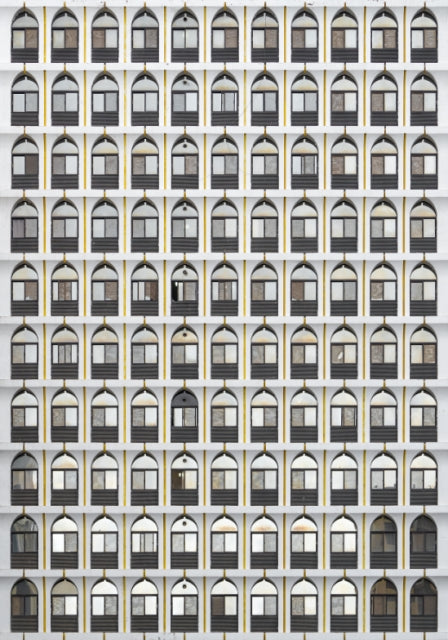
511 Airport Road
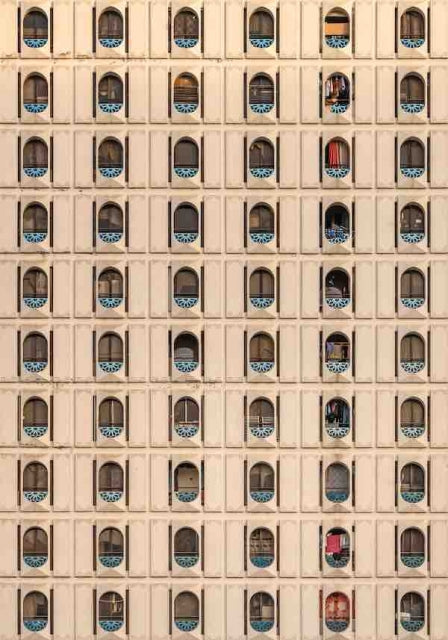
929 Electra Street
I find this really fascinating: systematic yet messy.
Documenting with clarity, which provides answers and raises more questions.
I mean, it's research to me, It’s pictorial research, but it is research. So it's almost like when you go about doing your PhD: you have a research question, you have a body of literature, you have so many things that might seem organized. Afterwards, you go about pursuing your answers, and you later discover that you’re asking the wrong question. Still, the quest towards understanding your own question in itself is valuable. You accumulate a body of knowledge that informs the future routes of your quest. The process is a bit daunting, but it is quite enjoyable, and you really have to believe in such a project.
For now, my quest is clear. But what's not clear is the identity of the UAE through facades. You can assume this is what the UAE looks like, but then you really have to gather all these facades, as data, see them in front of you, compare, and possibly organize them chronologically or by style, for you to have a better idea of how the country looks architecture wise.
As modern humans, we always take the shortest distance between two given points and we don't get to explore our surroundings. Our perception is subjected to that. So unless you go off the beaten path, unless you go for a stroll just for the fun of it, then you actually get to see things that you have never seen.
My role is not to take pictures only but to find what is worthy of documentation, which I think is even more fun than taking the pictures themselves.

511 Airport Road

929 Electra Street

929 Electra Street
Off the beaten path – that reminds me of geography readings.
It’s good that you’ve raised that. Because I have friends who do that with nature. At first you are an explorer, and then you become a photographer once you discover something worth taking a picture of. I do the same, but in an urban environment. And obviously, people think that you cannot do that in cities, because you don’t go off-roading. But you can do that mentally. Sometimes this might just mean venturing into a specific neighborhood that you had a certain perception about, and finding something different.
I remember from a previous talk where you mentioned that you mainly shoot here and don’t have many projects abroad.
So what's your relationship to photography when you travel, and why are your projects so focused on the UAE?
I have never actually been asked this before, even though it’s an important question. People sometimes send pictures of buildings from different places and tell me ‘you should take pictures of that!’ But to me, well, I started out by taking pictures in Melbourne, because I lived there. So it was more about understanding my own built environment.
Returning to the UAE, and given that I’m from here, gives me a certain perception about the built environment. So my quest is to show something that people didn't see here. And I think it’s my duty as an Emirati to show that. I believe that when people live in a place, whether they are native or not, it should be a kind of mission to showcase where they live. So that’s where the objective of documenting comes from, for me.
I did try to experiment with the same approach when I visited London, but I did not really find this culturally relevant. It has been done before and I felt that people living there were more qualified to document their surroundings. Living there gives you that ownership, and it takes time. I don’t photograph right away. I took 2-3 years to absorb my surroundings before taking pictures. So, in short, I do what I do because I feel it to be my duty.
I do have some overseas projects, at a conceptual stage, but my priority is the UAE right now. I see it as a lifetime project and it’s what keeps me alive creatively. I am more than happy to stick to one thing if it gives me purpose. And that, I think, is what sets you apart from other people.
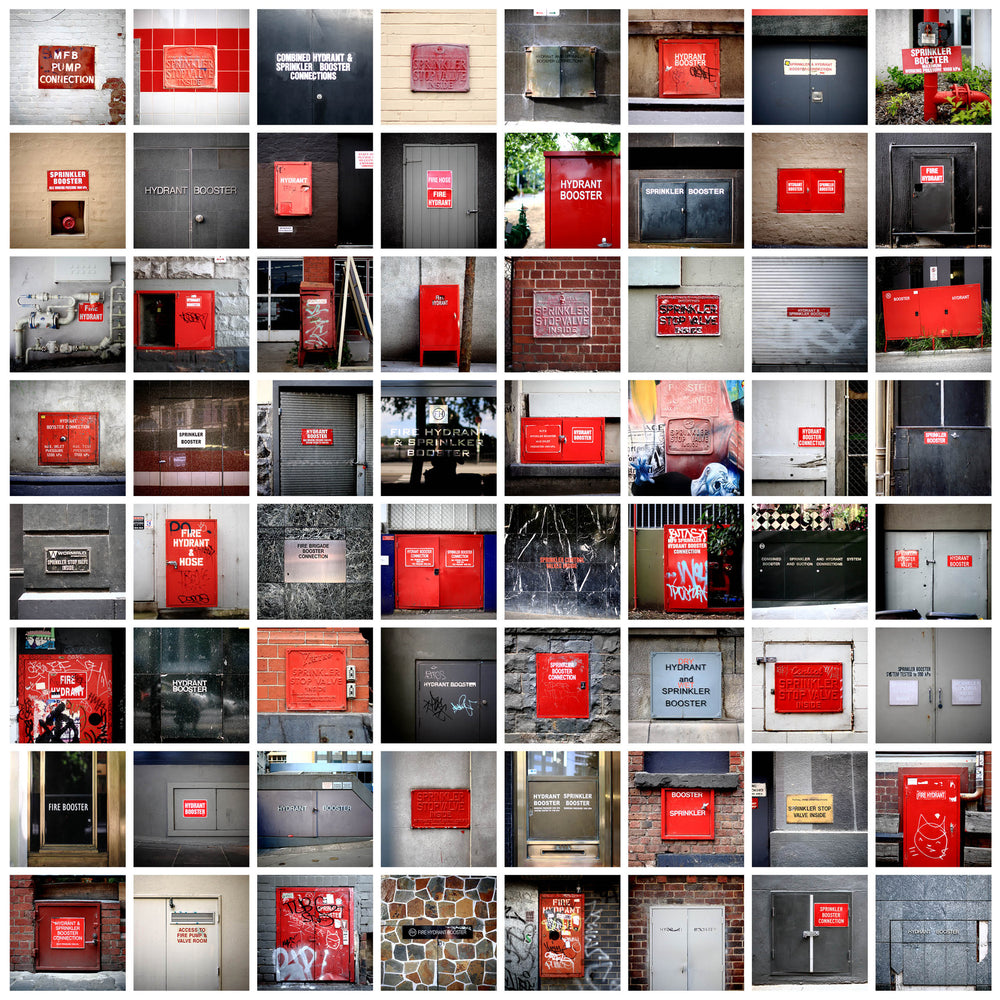
I know that you had projects on fire hydrants and parking signs in the past. Do you ever go back to those? Or have they reached their conclusion?
I think they did, and they speak of a specific phase in my career. I'm a graphic designer by profession and training. So I was initially looking at these elements purely as a designer until I started to absorb the bigger picture. Fire hydrant signs, let’s say, are elements of design, applied to different environments, and the designs consumed me for a while until I began to look at the entire urban context, which developed into my main aim of documenting as a way of better understanding that. At this stage, although I still notice these elements, and these fragments can help me understand spaces better, I want to focus on something bigger, and that’s how the shift from Hussain-the-graphic-designer to Hussain-who-documents-architecture started. I branched out to document facades for my own projects and for commissions.
Do commissioned projects require you to change your visual style or are you expected to document in your own way?
I have never actually been asked this before, even though it’s an important question. People sometimes send pictures of buildings from different places and tell me ‘you should take pictures of that!’ But to me, well, I started out by taking pictures in Melbourne, because I lived there. So it was more about understanding my own built environment.
Returning to the UAE, and given that I’m from here, gives me a certain perception about the built environment. So my quest is to show something that people didn't see here. And I think it’s my duty as an Emirati to show that. I believe that when people live in a place, whether they are native or not, it should be a kind of mission to showcase where they live. So that’s where the objective of documenting comes from, for me.
I did try to experiment with the same approach when I visited London, but I did not really find this culturally relevant. It has been done before and I felt that people living there were more qualified to document their surroundings. Living there gives you that ownership, and it takes time. I don’t photograph right away. I took 2-3 years to absorb my surroundings before taking pictures. So, in short, I do what I do because I feel it to be my duty.
I do have some overseas projects, at a conceptual stage, but my priority is the UAE right now. I see it as a lifetime project and it’s what keeps me alive creatively. I am more than happy to stick to one thing if it gives me purpose. And that, I think, is what sets you apart from other people.
I was about to correct myself when I used the word style, because from the way I was taught to look at it, it's always that the form needs to relate to the content. It's about approach rather than imposing a particular arbitrary style.
By all means it’s fine to use the term for good intentions, but as you said it’s not about the style, it’s about the purpose. Because let's say, you can have the style and then document buildings that are not worthy of documentation.
How do you evaluate buildings as having strong personalities?
What is your criteria?
With older buildings, pretty much, most of them have a strong personality, so I would document most of them. And obviously I would look at something that has an element that is a bit, I wouldn't say unique, but something that differentiates it from other buildings. So it could be the materials, it could be the shape of the windows, it could be the way it combines elements of modernism and elements that have to do with our region. I mean, speaking about the 70s, and 80s, buildings in this era have a lot of personality, even if they may not resonate with people.
Contemporary architecture is a challenge for me, because it is dull to my taste, and so I have to try a little harder to find elements that have a ‘personality’. Be it color or form. Of course, there is subjectivity there and at the end of the day I follow my intuition. I might be wrong sometimes. For me, it is not about capturing every single building, it’s about capturing an impression of every style and era, putting them together to construct the bigger picture. Of course, some people happen to appreciate single pictures because they connect with the buildings; either they live in them or they see them every day. That’s how the project becomes multidimensional.










